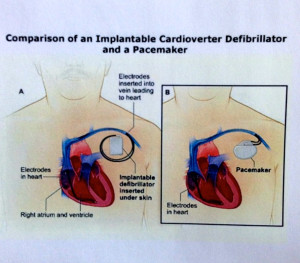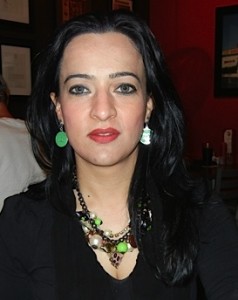Understanding the differences between a Pacemaker and a Defibrillator
A Defibrillator is also known as Automatic Implantable Cardioverter Defibrillator or (A.I.C.D) by Ayesha Shafiq
The eye of the understanding is like the eye of the sense; for as you may see great objects through small crannies or holes, so you may see great axioms of nature through small and contemptible instances.
– Frances Bacon.
Both a Pacemaker and a Defibrillator or (A.I.C.D.) are engineering marvels. These are miniature battery operated computers implanted in millions of patients across the world to regulate their heart rhythm and rate.
After a Pacemaker or a Defibrillator (A.I.C.D) is implanted in a patient's heart, his/her life becomes better. A patient starts having more energy and is able to continue with his/her regular life style and is able to resume old activities that he/she may have given up due to poor heart condition.
So what are the Differences between a Pacemaker and a Defibrillator (A.I.C.D)?

- A Pacemaker is slightly different than a Defibrillator.
If a patient suffers from slow heart rate, which can lead to heart failure, a Pacemaker is implanted. While fast, dangerous, irregular heartbeats which may lead to a heart attack, require a Defibrillator also called Automatic Implantable Cardioverter Defibrillator or (A.I.C.D.).
Though both the Pacemaker and a Defibrillator are about the size of a pocket watch yet, a Pacemaker is slightly smaller in size than a Defibrillator.
A Pacemaker only controls the heart rate and rhythm while a Defibrillator controls the heart rate, rhythm and can help with the pumping ability of the heart.
A Pacemaker remains activated all the time once implanted. While a Defibrillator only gets activated when a patient is having a life threatening arrhythmia. The Defibrillator works by emitting electronic pulses much like an external Defibrillator would shock the heart into beating again at the correct rate when an abnormal cardiac arrhythmia is detected.
Types of a Pacemaker and a Defibrillator (A.I.C.D.)
A Pacemaker comes in the following types:
Single lead Pacemaker: (1 lead) It only controls the rate and rhythm in the top or bottom part of the heart.
Dual Lead Pacemaker : (2 leads) It controls the rate and rhythm in the top and bottom part of the heart.
Bi- Ventricular Pacemaker: (3 leads) It controls the rate and rhythm in the top and bottom part of the heart and also helps in the pumping ability of the heart by resynchronizing the bottom right and the bottom left chambers of the heart.
A Defibrillator or Automatic Implantable Cardioverter Defibrillator (A.I.C.D.) comes in the following types:
Single Lead Defibrillator: (1 lead) It controls the heart rate and rhythm in the bottom part of the heart and also shocks the heart in case the bottom part of the heart develops a life threatening rhythm such as ventricular tachycardia or ventricular fibrillation.
Dual Lead Defibrillator: (2 leads) It controls the rate and rhythm in the top and bottom part of the heart and also shocks the heart in case the bottom part of the heart develops a life threatening rhythm such as ventricular tachycardia or ventricular fibrillation.
Bi-Ventricular Defibrillator: (3 leads) It controls the rate and rhythm in the top and bottom part of the heart and also helps in the pumping ability of the heart by resynchronizing the bottom right and the bottom left chambers of the heart. It also shocks the heart in case the bottom part of the heart develops a life threatening rhythm such as ventricular tachycardia or ventricular fibrillation.
How is a Pacemaker or a Defibrillator implanted?
Under conscious sedation, Dr. Khalid Shafiq an Interventional Cardiologist can implant a Pacemaker or a Defibrillator in a patient in the Cardiac Cath Lab at Paris Regional Medical Center.
A 4/5 cm incision is made either on the left/right side of the chest. Veins that run under the collarbone of the patient are used to access entry into the right side of the heart. The wires are placed in these veins called the subclavian veins. The wires are then attached to the generator and the wound is closed. The patient stays overnight at the hospital.
Follow up after a Pacemaker or a Defibrillator implant:
After Dr. Khalid Shafiq implants a Pacemaker or a Defibrillator in a patient, it requires regular follow up. No one can predict how long will a Pacemaker or Defibrillator last. In general you can predict your Pacemaker or Defibrillator to last several years. Pacemaker or Defibrillator batteries do not stop working suddenly. They give Dr. Shafiq several months warning that they are loosing power. Therefore regular Pacemaker or Defibrillator check ups become essential. Besides checking on the battery, these visits allow Dr. Shafiq to fine-tune your pacing prescriptions or to accommodate changes in your condition.
Dr. Shafiq communicates with your Pacemaker or Defibrillator by a device called the "Programmer". Attached to the Programmer is a TV remote control size device called a "Wand". Dr. Shafiq places the Wand on the implanted Pacemaker/ Defibrillator site on the patient's chest. This procedure is not painful. In fact you will feel nothing as the Programmer and the Pacemaker/ Defibrillator emit signals to communicate.
Programming Pacemakers/Defibrillators can be done in an office visit in a few minutes while a Pacemaker or Defibrillator check-up can be performed remotely from a patient's home over the Internet.
Life after a Pacemaker or a Defibrillator implant.
Contrary to common beliefs, patients with Pacemakers or Defibrillators can use household appliances, cell phones and microwave ovens. CT scans, ultrasounds and other medical imaging devices are still allowed. A Pacemaker or Defibrillator patient has to be careful only when getting in contact with large magnetic fields like in a setting of an MRI.
 |
Ayesha Shafiq, Director of Paris Cardiology Center. Wife of Khalid Shafiq M.D. and mother of their 2 children. Director of Paris Cardiology Center for 11 years. Masters in International Relations. Runs management with the help of 22 employees. |